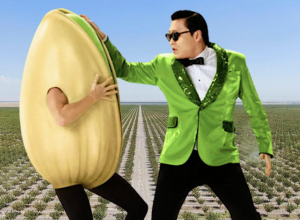
The endless rows of pistachio trees in California’s flat, arid Central Valley yield millions of bags of pricey green snack-nuts every year. A decade of celebrity-driven advertising has propelled pistachios into a global sales sensation—enough to attract major loans from institutional investors.
Like farming itself, lending to farmers can be risky. Last summer, agribusinesses owned by the Farid Assemi family defaulted on some $700 million in loans from Prudential Insurance Company of America and its affiliate, PGIM Real Estate Finance, plus some $50 million from Brighthouse Life Insurance and perhaps $200 million from others.
This past fall, those institutions, in separate actions, asked a federal judge in Fresno to appoint receivers to take possession of the loan collateral. The assets backing the debt included tens of thousands of acres of thirsty nut-bearing trees that, if not watered or pruned, could go to waste.

Farid Assemi
Why would those institutions lend that much money to one agribusiness and one somewhat faddish snack? The Assemis, originally from Tehran, are no ordinary farm family. They control about 10% of the pistachio-growing acreage in California, are major home builders, started a medical and pharmacy school, and donate to charities and politicians in the Fresno region.
Pistachios are no ordinary crop. They’ve exploded in production and consumption over the past decade. That success is due in no small part to Beverly Hills billionaires Stewart and Lynda Resnick. Their Wonderful Company has spent fortunes on a blizzard of tongue-in-cheek ads, including Super Bowl ads, in which Stephen Colbert, Dennis Rodman and other celebrities raved about the health benefits of pistachios.
The Resnicks and the Assemis were, until not long ago, close partners. If that partnership, or its collapse, was linked to Prudential’s or Brighthouse’s decisions to lend (or stop lending) to the Assemis, the two life annuity companies aren’t saying. RIJ wanted to know if the loans were examples of the “leveraged loans” or “private credit” deals that alternative asset managers increasingly “originate” for life/annuity companies. If so, the court filings in Fresno offer a glimpse into one of those ventures.
Money can grow on trees
In the Prudential lawsuit, filed last September 16, Prudential and PGIM REF (Prudential Global Investment Management Real Estate Finance) said that the Assemi family businesses have defaulted on some $705 million in debt and interest on loans dating back to 2017. The creditors asked for a court-appointed receiver to make sure the collateral—including some 50,000 acres (about 78 square miles, and more than 10% of all pistachio-bearing acreage in 2023) of perishable, water-hungry nut trees—isn’t ruined by heat, drought or neglect.
Brighthouse sued the Assemis’ farms in October 2024, claiming that they were owed $48.6 million for loans made by MetLife in 2017 and Brighthouse (formerly part of MetLife) in 2021. The loans were secured by almond and pistachio orchards. The court appointed receivers for that collateral in November and December 2024.
[Prudential and Brighthouse Financial were the 10th and 15th largest writers of annuities in the U.S. in the first nine months of 2024, with sales of $11.3 billion and $7.8 billion, respectively, according to LIMRA. They were the third and fourth leading sellers of registered index-linked annuities, with sales of $6.2 billion and $5.8 billion, respectively.]
U.S. Bank’s lawsuit, filed last September 17, claimed that the Assemi family, and its Touchstone pistachio processing plant venture, defaulted on a $41.25 million equipment and a $30.5 million line of credit, and that Touchstone owes U.S. Bank (which acquired the loans in its purchase of MUFG Union Bank in 2023) and a group of nut growers about $196 million. These loans were secured by a pistachio processing plant in the Central Valley town of Terra Bella, California.
Altogether, the three financial institutions appear to have combined exposures of $1 billion or more to the agribusinesses of Farid Assemi and his extended family, collateralized by 50,000 acres (~78 square miles) of pistachio or almond trees and equipment for a nut processing plant that never came to fruition. Court-appointed receivers are now burdened with keeping the trees healthy.
The lawsuits don’t explain why Prudential, PGIM REF, and U.S. Bank invested so heavily in the pistachio orchards. One obvious explanation: Pistachios are the nuts du jour. If you’ve been to a supermarket lately, you may have noticed the bags of shelled or unshelled pistachios piled in the produce section. They cost about $8 a pound, depending on how they’re processed and packaged.
No ordinary snack nut
Pistachio haven’t always been so popular, and California hasn’t always been its main source. In the early 1980s, Iran was the world’s top pistachio producer. In the U.S., pistachios were mainly a baking ingredient, typically found in a grocery’s bakery aisle. In 1986, however, the U.S. slapped a big tariff on Iranian pistachios. In 1989, Stewart and Lynda Resnick of Beverly Hills, billionaire owners of the Wonderful Company, ventured into the pistachio business.

The Resnicks, outstanding in their field
In 2007, the Wonderful Company inaugurated its quirky ‘Get Crackin’ TV ad campaign. Featuring celebrities like Steven Colbert and Dennis Rodman, the ads promoted pistachios as a highly nutritious. snack on TV shows like Survivor, America’s Got Talent and Good Morning America. (In 2013, their first Super Bowl ad featured Psy, the ‘Gangnam Style’ Korean pop star.)
The Wonderful Company “can take credit for moving pistachios out of the bakery aisle and into the produce aisle, where they are now positioned as a snack. They have definitely boosted demand,” said Jeff Conrad, president of AgIS Capital, a Boston-based private equity firm that specializes in agriculture. The U.S. is now the largest producer, consumer and exporter of pistachios in the world.
The U.S. accounted for 63% of global production of the nut in 2023-24. Our annual consumption of pistachios has soared to 225,000 metric tons from jU.S.t 41,500 metric tons in 2005. The U.S. shipped an additional 390,000 metric tons of pistachios abroad in 2023-24—about 70% of all pistachio exports.
PGIM REF is no stranger to agriculture loans, according to its website. The group has been “serving institutional investors seeking portfolio diversification into the farmland asset class since 1989” and has $10.4 billion in assets under management and administration. It focuses on row crops and “permanent plantings” such as pistachio and almond trees.
Pistachio trees are the kind of long-term investment an insurer can love. Seedlings take five to eight years to bear fruit and as much a 25 years to fully mature. A mature tree produces as much as 50 pounds of dry, hulled nuts for decades. Pistachios are biennial plants, bearing heavy crops every other year but little in between.
As an investment, agriculture has several attractions, according to Jamie Shen, managing director and head of agriculture at PGIM Real Estate. In interviews, she has listed the fact “We have a growing population and shrinking supply of arable land,” she said. PGIM, she added, looks for land that it can put solar panels on and for crops—including tree nuts—that can be mechanically harvested and processed.
“Historically, if you look at farmland as an investment, it’s pretty attractive,” Conrad told RIJ. “It has attractive long term returns on equity financing. It’s been a good inflation hedge. And it has a low-to-negative correlation with traditional investments.”
Family feud
There’s a dramatic twist to this story: the Assemi family and the Resnicks were once partners at the apex of the pistachio business.
The patriarch of the Assemi clan, Farid, the eldest son of a prosperous Iranian agricultural family, arrived in California from Tehran in 1974. His family’s fortune, based on wells, farm equipment, and land holdings in Iran, according to the Fresno Bee reports, bankrolled him in the Central Valley.
The Assemi Group, based in Fresno, became a leader in land acquisition, land development, home building, farming, medical education, and aviation in the Central Valley. By 1997, it created or acquired many individual farms with colorful names like Maricopa Orchards, Sageberry Farms, and Panoche Pistachios, across tens of thousands of acres.
The Resnicks, meanwhile, were building Wonderful’s future pistachio empire. In 1989, they formed Paramount Farms to cultivate pistachios and almonds. In 1994, a Paramount subsidiary quietly acquired a 48% controlling interest in the Kern Water Bank, a publicly-financed set of water recharge basins across 32 acres in the southern San Joaquin Valley, with a capacity of 1.5 million acre-feet of water.
The Resnicks also controlled a strategic lending source. As the Wall Street Journal reported in 2016 and 2018, the Resnicks, whose charitable foundation would become a major donor to art, health, and education institutions in Los Angeles and beyond, also loaned foundation money to businesses affiliated with the Resnicks.
The Resnicks created another advantage: “super trees.” In the late 2000s, according to press reports, the Resnicks began collecting data on the yields of pistachio trees in their orchards. They cloned the most productive ones, which yielded 25% more than normal.
The Resnicks and the Assemis went into business in the early 2000s. The Assemis were engaged as key suppliers to the Resnicks’ nut processing operation. Over the next decade, the Resnicks would loan tens of millions of dollars—$45 million from their charity, according to the Wall Street Journal—and a supply of super-trees in return for years of steady supplies of nuts for processing, distribution and sale worldwide.
The relationship grew tenuous and then troubled in the late 2010s. Kevin Assemi, Farid’s son, decided to try to establish—in a venture with the code-name, Project X, according to U.S. Bank’s court filings—the Assemis’ own pistachio processing plant in Terra Bella, California. That meant head-to-head competition, not friendly cooperation, with the Resnicks.
Unable to come to terms for the delivery of their 2019 crop, the Assemis withheld it from the Resnicks and sued them for $30 million. The Resnicks counter-sued for $170 million, charging that the Assemis owed them a decade’s worth of pistachios. Although a jury would eventually deem both suits baseless, in January 2024 jurors affirmed secondary claims and awarded $38.7 million to the Assemis and $11.3 million to the Resnicks.
That settlement didn’t rescue the Assemis, however. Unable to find new lenders or buyers for their properties, and weakened by Farid Assemi’s health problems and the departure of several key employees, they defaulted on their outstanding loans in mid-2024.
‘Private credit’ or not
It’s unclear exactly how the two life/annuity giants became involved in this evidently emotional, high-stakes dispute between former friends. The U.S. Bank lawsuit against the Assemis hints at relationships and maneuvers of unanticipated complexity:
In the spring of 2022, Touchstone’s management came to [U.S. Bank] seeking permission to enter a complicated arrangement under which Touchstone would finance the expansion of an existing [pistachio processing] plant owned by a third party (Dry Ranch), and purchase the facility upon completion. The Assemis referred to this as “Project X.”
Part of the plan was a daisy-chain of loans whereby Prudential Insurance, which was Maricopa’s main real-estate lender, would loan Maricopa $50 million secured by Maricopa’s orchards. Maricopa would in turn loan that money to Touchstone, which would use it to help make a construction loan to Dry Ranch for Project X. Once the building shell was constructed, Touchstone would deliver some of the equipment it had purchased for… Project X. Touchstone would ultimately purchase the plant upon completion.
More research is needed to show why Brighthouse and Prudential together loaned so much to the Assemis. That the two institutions took positions in the pistachio business is no mystery; private capital firms, lured by the prospect of high long-term profits, have poured millions into almond and pistachio groves in Arizona and California in recent years.
The risks of lending tens or hundreds of millions to one family seem patent in hindsight, but the potential returns must have outweighed the potential risks at the outset. The Assemis may have looked bankable at the start of 2020, but the pistachio crop in 2022 was one of the worst in years, interest rates went up, and Covid hit supply chains and increased labor costs.
In late September, Prudential Insurance extended $32 million to the receiver in their lawsuit to oversee the harvest of a multi-million crop of pistachios and almonds.
Merely taking possession of the collateral backing their loans may not satisfy either Brighthouse or Prudential. “Traditional lenders don’t lend money with hopes of getting the asset,” said Jeff Conrad at AgIS Capital. “They don’t have the infrastructure set up to manage companies. The regulators don’t like to see it on the balance sheet.”
Traditional life/annuity companies like Prudential and Brighthouse were once known for buying corporate bonds in the public bond markets, and that’s still their bread-and-butter asset. But over the past 10 years, they’ve watched private equity-led life/annuity companies use their skills in leveraged loan origination (aka private credit) to enhance profits and grow annuity market share. If the two insurers’ loans to the Assemis fall into the private credit category, then their legal actions offer the public a glimpse into the potential risks of such deals.
The California pistachio industry is expected to grow steadily. According to a report commissioned by the American Pistachio Growers, California produced 1.36 billion pounds of pistachios on 453,750 bearing acres in 2023, but is expected to produce 2.08 billion pounds on 811,000 acres in 2031.
© 2025 RIJ Publishing LLC. All rights reserved.

